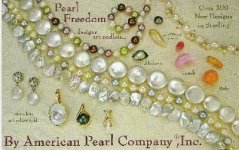Z
Zeide Erskine
Guest
Hi Bogus,
The mantle tissue is the part of a mussel that forms the shell. If you transplant a piece of this mantle tissue someplace else within the same animal or into an open wound of another animal it will bond into the local blood circulation, the connective tissue disintegrates and the conchiolin producing and calcium carbonate secreting cell islands will multiply and grow together to form a three dimensional pearl sac. The shape of the original tissue implant determines the final shape of the pearl sac although available body cavity space may cause indentations that then lead to changes in the shape of the pearl being created.
In contrast to what one often hears, there is no residual tissue inside the pearl that forms. There may be an original conchiolin clump at the center of a pearl if the nucleation was done while the mussel was active and secreting more conchiolin. If the mussel was nucleated in the dormant months, there will be no measurable conchiolin clump at the core. The aragonite crystals grow along the folds of the conchiolin protein. As such, a tissue nucleated pearl is indeed a true pearl albeit a cultured one. The final size of the pearl is due to cultivation time and available ambient calcium.
And, of course, you cannot grow 50 at a time if you intend to grow big rounds. The ambient calcium limits the amount of nacre a mussel can precipitate. Also in 50 nucleations the pearls would all grow together into a clump if you did not harvest them at around 6mm. So for the big rounds, you need space in the mussel and patience. It happens by accident when a multi-nucleated mussel dissolves most of the other implants and only lets 1 or 2 grow at the same time. You can greatly increase your yield of big rounds by only implanting one or two tissue grafts. The size of the tissue graft also influences the speed of pearl growth. This technique of implanting just one or two large, round tissue grafts has already been making inroads in China for years. The multiple nucleation thing with 20 or even 50 grafts will only yield beading grade pearls with too much conchiolin that renders them murky, off-round shapes because their pearl sacs touch, and more often than not grown together pearls called peanuts.
I hope this helps,
Zeide
The mantle tissue is the part of a mussel that forms the shell. If you transplant a piece of this mantle tissue someplace else within the same animal or into an open wound of another animal it will bond into the local blood circulation, the connective tissue disintegrates and the conchiolin producing and calcium carbonate secreting cell islands will multiply and grow together to form a three dimensional pearl sac. The shape of the original tissue implant determines the final shape of the pearl sac although available body cavity space may cause indentations that then lead to changes in the shape of the pearl being created.
In contrast to what one often hears, there is no residual tissue inside the pearl that forms. There may be an original conchiolin clump at the center of a pearl if the nucleation was done while the mussel was active and secreting more conchiolin. If the mussel was nucleated in the dormant months, there will be no measurable conchiolin clump at the core. The aragonite crystals grow along the folds of the conchiolin protein. As such, a tissue nucleated pearl is indeed a true pearl albeit a cultured one. The final size of the pearl is due to cultivation time and available ambient calcium.
And, of course, you cannot grow 50 at a time if you intend to grow big rounds. The ambient calcium limits the amount of nacre a mussel can precipitate. Also in 50 nucleations the pearls would all grow together into a clump if you did not harvest them at around 6mm. So for the big rounds, you need space in the mussel and patience. It happens by accident when a multi-nucleated mussel dissolves most of the other implants and only lets 1 or 2 grow at the same time. You can greatly increase your yield of big rounds by only implanting one or two tissue grafts. The size of the tissue graft also influences the speed of pearl growth. This technique of implanting just one or two large, round tissue grafts has already been making inroads in China for years. The multiple nucleation thing with 20 or even 50 grafts will only yield beading grade pearls with too much conchiolin that renders them murky, off-round shapes because their pearl sacs touch, and more often than not grown together pearls called peanuts.
I hope this helps,
Zeide
Last edited by a moderator:

